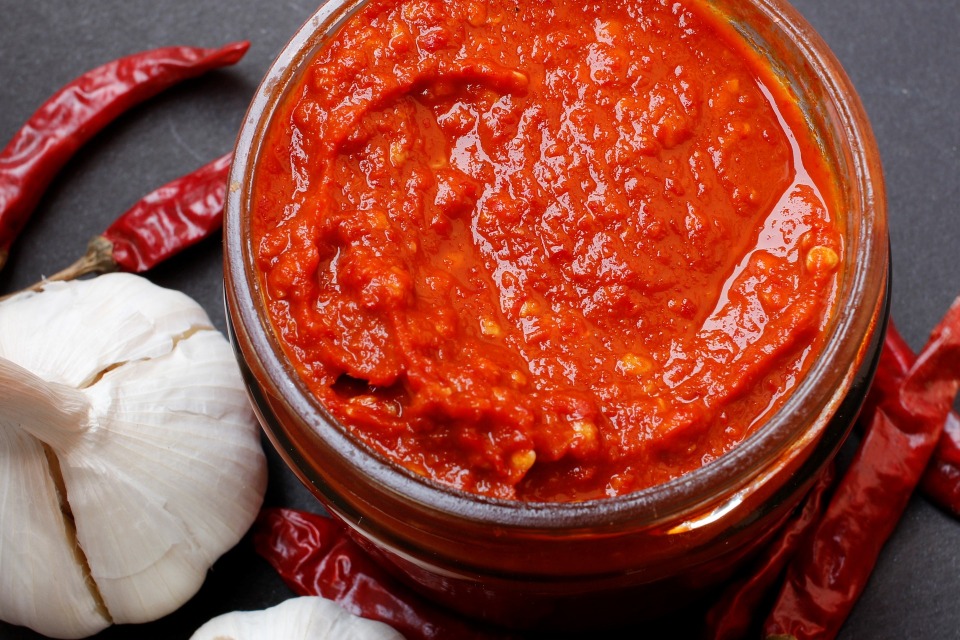Chutneys are chutneys. It was hard to verbalize what makes a chutney a chutney, so we got to thinking and reading. We soon realized that no matter where one travels in the world, each cuisine has little dishes of condiments with big flavors. These dishes go by many names:
- Salsa
- Relish
- Sambal
- Chow Chow
- Atjar
- Ketchup
- And Chutney!
The names are many, but the concept is the same. Fruits, vegetables, herbs, and spices come together to create intense flavors that bring excitement to everyday foods. And although each dish has its own name, flavor, and origin, they all have a balance of sweet, spicy, savory, and sour. Chutney is one of those little dishes.
Chutney most likely originated in South Asia but can be found in many food traditions.

In the United States, we are all familiar with cranberry sauce which meets the definition of a chutney! During colonial times, many families who became wealthy through trade in India came to the United States. It is believed their Indian cooks took the tradition of chutneys and adapted them to what was available. Hence, cranberry sauce and other chutneys became part of our food story.
So are chutney and relish the same thing?
So what makes one a relish instead of chutney? Or a ketchup instead of a sambal? There isn’t always an exact definition of any of these little condiments. Instead, the name of each dish depends on where it is made. A salsa made in Mexico isn’t all that different from a sambal made in Java.
The methodology and ease of making them are what bring all these dishes into the same category. How to make chutney, salsa, and relish is pretty much the same! Combine fresh ingredients with acid, sweetness, and a bit of spice. Some are cooked. Some are eaten raw.

This balance and wild intensity is the key to these dishes. A dab of chutney or a squeeze of ketchup serves the same purpose – a way to dress up plain food. A bowl of plain cooked beans in the Southern United States is often brightened up with a spoonful or two of chow chow. And in Mexico, that same bowl of beans would be anointed with freshly made salsa. It’s not unusual in India to serve fish with a chutney or two, and in Indonesia, that same fish would be served with an atjar (a chutney with fish sauce). All bring a burst of flavor to everyday foods!
So are chutneys healthy?
And what are the ingredients in chutney?
Both of these questions can be answered together. Chutneys and all of these dishes are an integral part of unconscious healthfulness found in many cuisines around the world. Largely created from vegetables, fruits, herbs, and spices, they are naturally low in calories and plant-based. So yes, chutneys are a healthy way to add gusto to just about any food!

How do you make chutneys?
All of these dishes are easy to make. Most require no more than a bit of chopping and mixing. Some require 10 – 15 minutes of cooking. But since these little dishes keep very well in the refrigerator, they are easy to have on hand and use whenever the mood strikes. And make creating a delicious meal all that much easier!
Put some chicken on the grill or in the oven. Pull out a salsa or relish or chutney you’ve made earlier and a balanced yummy meal is done!
Curried Pineapple Chutney

One of our go-to chutneys is our Curried Pineapple Chutney. This sweet, savory, and spicy chutney recipe tastes complex, but like most chutney recipes is easy to make and to substitute ingredients. We’ve made this same recipe with apples and apple cider instead of pineapple and pineapple juice. Feel free to adjust how much chile and curry powders you add therefore adjusting the heat level.
How to serve Curried Pineapple Chutney?
- A lovely side to grilled meat or fish
- Use as a sauce on top of simple sauteed shrimp
- Serve with soft cheeses like cream cheese or brie.
- Dollop on top of a pot of beans.
It’s a complex little dish to make everyday foods something special!

What is Chutney?
Ingredients
Instructions
-
In a medium saute pan, heat oil over medium-high heat until it shimmers.
-
Add the bell peppers and onion. Season with salt and pepper. Saute until the onions are translucent.
-
Push ingredients in pan to the edge. Add the ginger, chile, and curry powders to the center of the pan. Saute 1 minute more.
-
Add remaining ingredients.
-
Reduce heat to low and simmer for 10-15 minutes until thickened. Stir often while simmering.
-
Allow to cool for at least 15 minutes before enjoying.


